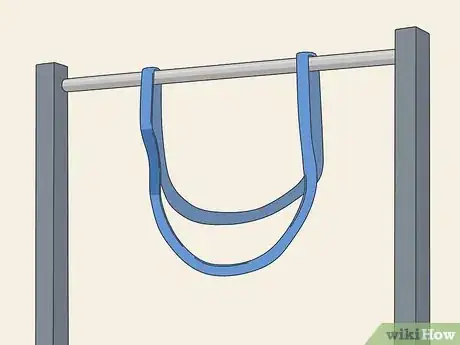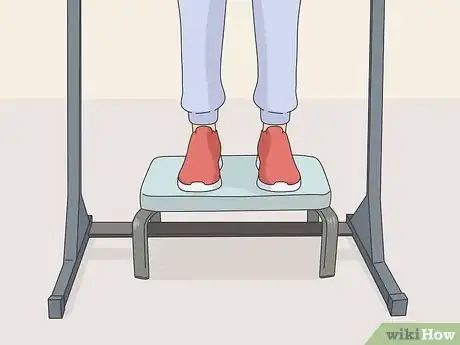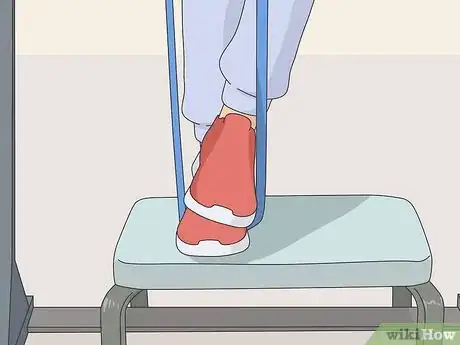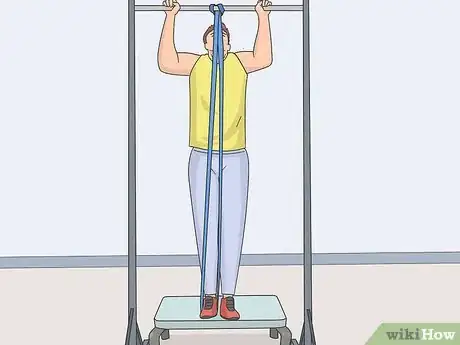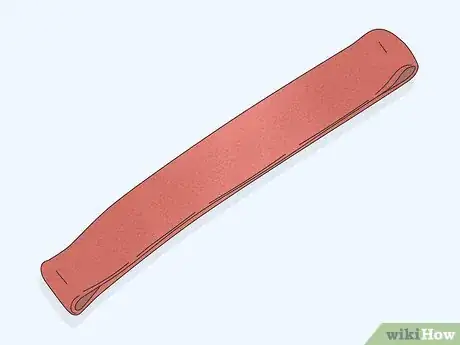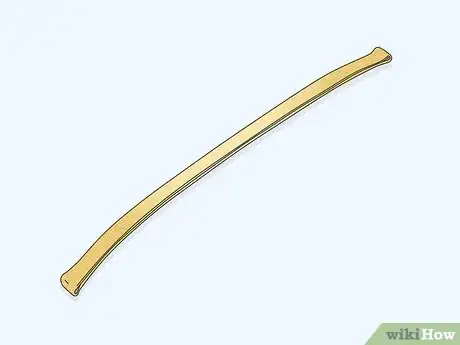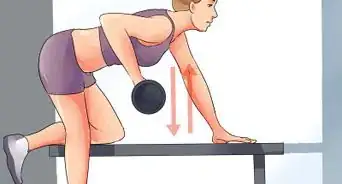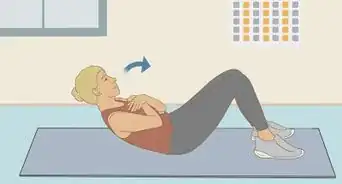This article was co-authored by wikiHow staff writer, Eric McClure. Eric McClure is an editing fellow at wikiHow where he has been editing, researching, and creating content since 2019. A former educator and poet, his work has appeared in Carcinogenic Poetry, Shot Glass Journal, Prairie Margins, and The Rusty Nail. His digital chapbook, The Internet, was also published in TL;DR Magazine. He was the winner of the Paul Carroll award for outstanding achievement in creative writing in 2014, and he was a featured reader at the Poetry Foundation’s Open Door Reading Series in 2015. Eric holds a BA in English from the University of Illinois at Chicago, and an MEd in secondary education from DePaul University.
There are 10 references cited in this article, which can be found at the bottom of the page.
This article has been viewed 12,439 times.
Learn more...
Using a resistance band to do pull ups is a great way to reduce how much weight you’re responsible for with each repetition. They’re also a phenomenal way to focus on your form as you build up to regular pull ups. Get a set of bands with different levels of resistance and start with strongest one. Work your way down to the lowest level of resistance before abandoning the bands altogether. To use a resistance band, wrap it around the pull up bar and slide one end of the band through the other. Pull the band down and slide your foot inside the loop. As you do your pull ups, rely on the band to hold your weight and help you balance.
Steps
Wrapping the Band around a Pull up Bar
-
1Purchase a set of bands and start with the strongest one. The bands used to assist with pull ups are called resistance or tension bands. They come in a variety of colors to help indicate the band’s level of resistance. The more resistance in the band, the stronger it is; the stronger the band is, the more assistance it will provide when doing pull ups. Use the band with the highest level of resistance to start.[1]
- The level of resistance is usually printed directly on the band, but you can use the width of the band to determine the level as well. The wider the band, the more resistance it provides. Alternatively, you can simply try pulling the band from both ends. The harder it is to pull, the higher the resistance.
- While there may be common themes (red is usually the middle of the spectrum), the band colors are not universal and you cannot rely on the color of the band to determine the resistance.
-
2Toss the band over the pull up bar so that it rests in the middle. If you can’t reach the pull up bar without jumping, use a stool or platform to comfortably reach it. Take your resistance band and drape it over the top of your pull up bar in the center. Adjust either end of the band so that the pull up bar is in the middle of the resistance band.[2]
Tip: Make sure that your pull up bar is dry. If you’re using a pull up bar in a gym, wipe it down with a towel or cloth if someone else has been using it. If the bar isn’t dry, the resistance band may slide back and forth and make it difficult to stabilize yourself.
Advertisement -
3Take one end of the band and slide it through the other side. Grab one end of the band in one hand and grab the other end of the band in your other hand. Take one end of the band and slide it underneath the pull up bar and through the opening on the opposite side. Your band is now secured to your pull up bar.[3]
-
4Pull the end of the resistance band down to tighten it. With the end you slid through the opening hanging down from the bar, pull down firmly on the band. This will make the loop around your pull up bar taut and keep it from sliding around as you perform your pull up.[4]
Doing a Pull up
-
1Set a platform underneath you if you can’t reach the pull up bar. If you cannot reach the pull up bar while you’re standing on the ground, slide a small box, step ladder, or crate under the bar. Orient it so that the edge of your platform is directly underneath the bar.[5]
- You will rely on the platform to step into the band and to let yourself down after doing pull ups.
-
2Slide your dominant foot into the opening of the band. Grab the band and pull it down 2–4 feet (0.61–1.22 m). Put the arch of your shoe against the lowest point of the band and push it down a little bit. Use the tension of the band and the bar to stabilize your body.[6]
- You must be wearing shoes to use a pull up band. Don't do this barefoot!
-
3Grip the pull bar with both hands. Grab the bar with your palms facing away from your body. Keep your hands spread 1–2 feet (0.30–0.61 m) away from the center of the bar based on what’s comfortable for you.
-
4Slide your nondominant foot over your dominant foot to hold it in place. With your feet resting on the ground or the platform, raise your nondominant foot off of the ground. Slide your nondominant foot over the dominant foot and angle it slightly towards the ground. This will keep the band from sliding out away from you while you perform your pull ups.[7]
- If you don’t put your free foot over the leg with the resistance band, it may slide out from underneath you as you pull yourself up. This could be dangerous, since all of your weight will return while you’re holding the bar.
- If you aren’t struggling to balance yourself when you do pull ups, you can skip this step once you get used to the band.
Variation: Once you get good at this, bend your nondominant leg behind you at a 90-degree angle to stretch your leg muscles while you perform your pull ups. Alternate which leg holds the band and which leg bends behind you after every set.[8]
-
5Activate your core and pull yourself up to the bar. Tighten your core and stabilize your weight on the resistance band. Bend your knees a little and raise your feet 6–12 inches (15–30 cm) off of the ground. Using your shoulder, arm, and back muscles, pull your chin up to the bar. Continue raising yourself up until your chin is at, or slightly above, the level of the bar.[9]
- Keep your back as straight as possible while doing this.
-
6Lower yourself down slowly to complete 1 rep. Once your chin is at bar-level or slightly above it, carefully lower yourself down. Control your weight and move slowly to gently lower your body to its original position. Do not let your arms lock up or hang and keep your core and back muscles tight. Once you reach your original position, you can dismount or continue doing more reps.[10]
- Do not lean forward or backward while pulling yourself up and lowering yourself down to keep the band centered under you.
-
7Release the pull up bar and hold the band still to remove your feet. When you’re done with your pull ups, loosen your arms and let your feet touch the floor or the platform you were originally standing on. Release the pull up bar but don’t move your feet. Then, grip both sides of the band tight and lift your foot out of the band.[11]
- If you don’t hold the band while taking your foot out, the band may shoot up and possibly hit you.
- As you get used to balancing yourself, alternate which foot is holding the band in place to give each of your legs a stretch when you work out.
Adding Reps and Switching Bands
-
1Start with 5-10 reps and move up from there as you get stronger. Starting with a strong band is a great way to practice your form as you get stronger. Pick a repetition goal based on your ability to do an unassisted pull up. Starting low with 5 or 10 reps is a good general guideline. Slowly work your way up to 15 or 20 reps.[12]
- Once you reach your goal on the high-resistance band, switch to the low-resistance band and continue working out until you get back up to your original goal.
- If you aren’t good at pull ups, don’t worry about setting a low goal! Everyone starts somewhere, and the bands are designed to help you get up to a high number of repetitions.
-
2Use a high-resistance band to start out if you’re new to pull ups. If you’re a beginner, start out with a high-resistance band. The high-resistance band will reduce the amount of weight you’re responsible for when you perform a pull up. This will give you a break and help you focus on your form as you work out regularly.[13]
- The high-resistant band is typically black, yellow or green. It is almost always the widest band in a set of resistance bands.
-
3Switch to a medium-resistance band to increase repetitions. Once you perfect your form and increase your back, shoulder, and arm strength, swap your high-resistance band out for a medium-resistance band. You will immediately notice that your pull ups are harder, since the band is no longer supporting a large percentage of your weight.[14]
- The medium resistance band is usually red, but it may also be blue. They are usually less than 2 inches (5.1 cm) in width.
-
4Use a light-resistance band to work up to doing unassisted pull ups. Once you’re comfortable doing pull ups with the medium-resistance band, swap to a lighter level of resistance. Continue working out regularly until you no longer need the resistance band and can perform pull ups without any weight assistance.[15]
Tip: The goal of using resistance bands is to not need them at all. If you perform pull ups 2-3 times a week, you can accomplish this transition in as little as 2-3 months. For some people it may take longer, though.
References
- ↑ https://cdn.shopify.com/s/files/1/0015/1194/8382/files/Pull_Up_Band_Guide_MyFitness_Home.pdf
- ↑ https://cdn.shopify.com/s/files/1/0015/1194/8382/files/Pull_Up_Band_Guide_MyFitness_Home.pdf
- ↑ https://cdn.shopify.com/s/files/1/0015/1194/8382/files/Pull_Up_Band_Guide_MyFitness_Home.pdf
- ↑ https://cdn.shopify.com/s/files/1/0015/1194/8382/files/Pull_Up_Band_Guide_MyFitness_Home.pdf
- ↑ https://youtu.be/7yqudG7vnow?t=67
- ↑ https://youtu.be/7yqudG7vnow?t=79
- ↑ https://youtu.be/7yqudG7vnow?t=83
- ↑ https://cdn.shopify.com/s/files/1/0015/1194/8382/files/Pull_Up_Band_Guide_MyFitness_Home.pdf
- ↑ https://youtu.be/7yqudG7vnow?t=102

